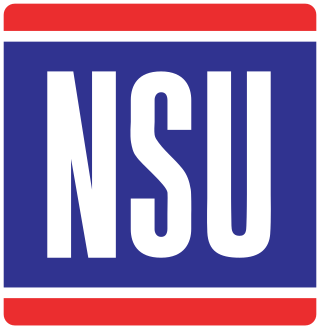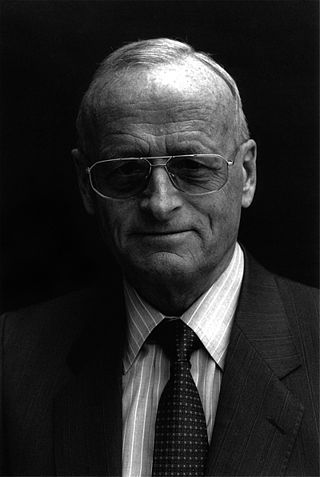
Volkswagen is a German automobile manufacturer headquartered in Wolfsburg, Lower Saxony, Germany. Founded in 1937 by the German Labour Front under the Nazi Party and revived into the global brand it is known as today post World War II by the British Army officer Ivan Hirst, it is known for the iconic Beetle and serves as the flagship brand of the Volkswagen Group, the largest automotive manufacturer by worldwide sales in 2016 and 2017. The group's biggest market is in China, which delivers 40 percent of its sales and profits. Its name is derived from the German-language terms Volk and Wagen, translating to "people's car" when combined.

Volkswagen AG, known internationally as the Volkswagen Group, is a German multinational automotive manufacturer headquartered in Wolfsburg, Lower Saxony, Germany. The company designs, manufactures, and distributes passenger and commercial vehicles, motorcycles, engines and turbomachinery, as well as offers related services, including financing, leasing, and fleet management. In 2016, it was the world's largest automaker by sales, and keeping this title in 2017, 2018, and 2019, selling 10.9 million vehicles and was the largest automaker by revenue in 2022. It has maintained the largest market share in Europe for over two decades. It ranked seventh in the 2020 Fortune Global 500 list of the world's largest companies. In Forbes Global 2000 2023 Volkswagen Group ranked 29th.

Wolfsburg is the fifth largest city in the German state of Lower Saxony, located on the river Aller. It lies about 75 km (47 mi) east of Hanover and 230 km (143 mi) west of Berlin.

The Volkswagen Scirocco is a three-door, front-engine, front-wheel-drive, sport compact hatchback manufactured and marketed by Volkswagen in two generations from 1974 to 1992 and a third generation from 2008 until 2017. Production ended without a successor.

Auto Union AG was an amalgamation of four German automobile manufacturers, founded in 1932 and established in 1936 in Chemnitz, Saxony. It is the immediate predecessor of Audi as it is known today.

The Volkswagen Santana is a nameplate used by Volkswagen for various sedans and station wagons since 1983. The first generation is based on the second-generation Volkswagen Passat (B2). It was introduced in 1981 while production started in 1983 for China. The use of the "Santana" badge rather than "Passat" echoes the use of different names for the sedan versions of the Polo (Derby) and Golf (Jetta).

NSU Motorenwerke AG, or NSU, was a German manufacturer of automobiles, motorcycles and pedal cycles, founded in 1873. Acquired by Volkswagen Group in 1969, VW merged NSU with Auto Union, creating Audi NSU Auto Union AG, ultimately Audi. The name NSU originated as an abbreviation of "Neckarsulm", the city where NSU was located.

The Audi 50 is a small 'Supermini' car, produced by German automaker Audi from 1974 to 1978, and sold only in Europe. Introduced two and three years after the French Renault 5 and the Italian Fiat 127 respectively, the Audi 50 and its VW Polo twin were seen at the time as Germany's first home-grown entrant in Europe's emerging class of "supermini" hatchbacks, supplanting a generation of small and often rear-engined economy cars.

Bernd Peter Pischetsrieder is a German automobile engineer and manager.

Carl Horst Hahn was a German businessman and head of the Volkswagen Group from 1982 to 1993. He served as the chairman of the board of management of the parent company, Volkswagen AG. During his tenure, the group's car production increased from two million units in 1982 to 3.5 million a decade later.

Toni Schmücker was the fourth chief executive officer of the Volkswagen automobile company, following the handover of the company in 1948 to German control from the British, who had administered the VW factory in Wolfsburg, Germany after the Second World War ended.

Dr. Ing. h.c. Rudolf Leiding was the third post-war chairman of the Volkswagen automobile company, succeeding Kurt Lotz in 1971.

The Volkswagen Golf Mk2 is a hatchback, the second generation of the Volkswagen Golf and the successor to the Volkswagen Golf Mk1. It was Volkswagen's highest volume seller from 1983 and ended in (German) production in late 1992, to be replaced by the Volkswagen Golf Mk3. The Mk2 was larger than the Mk1; its wheelbase grew slightly, as did exterior dimensions. Weight was up accordingly by about 120 kg (260 lb). Exterior design, developed in-house by VW design director Schäfer, kept the general lines of its Giugiaro-designed predecessor, but was slightly more rounded. All told, about 6.3 million second-generation Golfs were built.

Porsche Automobil Holding SE, usually shortened to Porsche SE, is a German multinational corporation primarily known as a holding company of Volkswagen Group with investments in the automotive industry. Porsche SE is headquartered in Zuffenhausen, a city district of Stuttgart, Baden-Württemberg and is majority owned by the Austrian-German Porsche-Piëch family. The company was founded in Stuttgart as Dr. Ing. h.c. F. Porsche GmbH in 1931 by Ferdinand Porsche (1875–1951) and his son-in-law Anton Piëch (1894–1952).

The automotive industry in Germany is one of the largest employers in the world, with a labor force of over 857,336 (2016) working in the industry.
Volkswagen Westmoreland Assembly was a manufacturing complex located 35 miles (56 km) southeast of Pittsburgh in Westmoreland County, Pennsylvania, near New Stanton — and noted for manufacturing 1.15 million Volkswagens from 1978 until 1987. When VWoA began manufacturing in the unfinished Chrysler plant, it became the first foreign automobile company to build cars in the US since Rolls-Royce manufactured cars in Springfield, Massachusetts, from 1921 to 1931.

Volkswagenwerk Braunschweig is a factory site for Volkswagen automobile parts in Braunschweig, Germany. Production started on 1938-02-23 for manufacturing steering components of „KdF-Wagen" and tools for Junkers Flugzeug- und Motorenwerke in Dessau. Until today, only components for vehicles of VW Group are produced, such as running gears, axles, shock absorbers, brake parts and all pedals.

The Volkswagen Auto 2000 is a concept car first shown by German car company Volkswagen in 1981. It was part of a German government-sponsored program to develop cars for the year 2000. Volkswagen's prototype was joined by efforts from Audi, Mercedes-Benz, and the University Working Group HAG (Hochschularbeitsgemeinschaft). As with the other Auto 2000 concepts, Volkswagen's car focused on fuel economy through the use of efficient engines and streamlining, and many of its features were to end up in series production.
The Volkswagen Zwickau-Mosel Plant is an automobile factory in today's Zwickau district of Mosel, Germany. Founded on 26 September 1990, together with the Chemnitz plant and the Transparent Factory, it belongs to Volkswagen Sachsen, based in Zwickau. Currently, the Zwickau plant has about 8,000 employees. Signalling a milestone the last combustion vehicle was produced on 26 June 2020.

Workers of the German auto manufacturer Volkswagen Group are collectively organized and represented across a variety of worker organizations including trade unions and Works Councils across the globe. Workers are organized on multiple levels; locally, regionally, nationally, internationally and by marque.





















